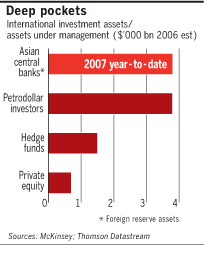Temasek joins the Wall Street party
Roula Khalaf, Editor of the FT, selects her favourite stories in this weekly newsletter.
And Merrill Lynch makes four. Temasek’s potential multibillion-dollar stake in the US investment bank would mean Asian and Middle Eastern sovereign funds had unveiled plans for about $25bn of investments in bruised international banks in the past month. New investors of first resort have already pumped up the balance sheets of Citigroup, UBS and Morgan Stanley.

There is more where that came from. Asia’s central banks hold foreign exchange reserves of about $3,800bn; some is being hived off into actively managed funds. Singapore, ahead of the game by 20 years, is reckoned to have a $440bn or so in investment agencies Temasek and GIC. China’s fledgeling sovereign wealth fund has lost about 20 per cent on its maiden investment in Blackstone – but this is small beer. Together the $3bn invested in the private equity firm and this week’s $5bn injection into Morgan Stanley equate to less than a week’s build-up of foreign exchange reserves.
Where next? Banks and financial institutions remain in the spotlight. They are trading on low valuation multiples (especially compared with China’s domestic banks, valued on about five to seven times book). Deals such as the stake in Morgan Stanley, structured via convertible bonds, tick other boxes. The coupon is a healthy 9 per cent.
Just as investing in private equity firms should ensure preferential access to funds, so a capital alliance with a bank should bring commercial benefits. Strategic objectives will feature too: that could mean technology transfer and securing natural resources.
Equally, the desire to head off protectionism could prompt less obvious investments designed to build trust overseas. But the sheer depth of funds means equity portfolio investment will account for some of the cash, possibly farmed out to asset managers. Either way, legions of advisers, bankers and would-be recipients will be knocking on Asian doors next year.
Comments